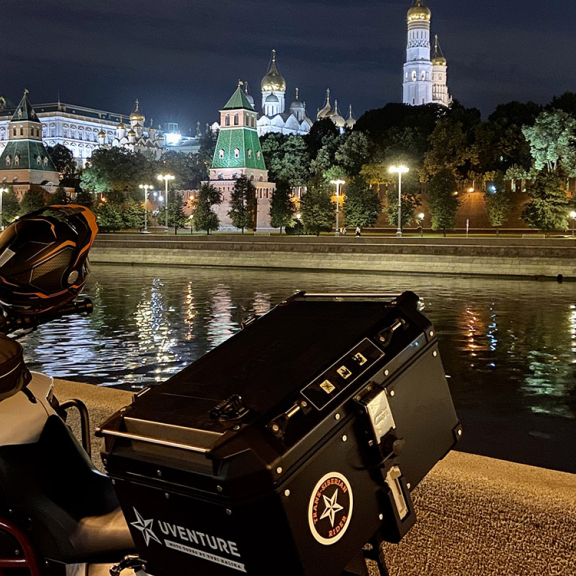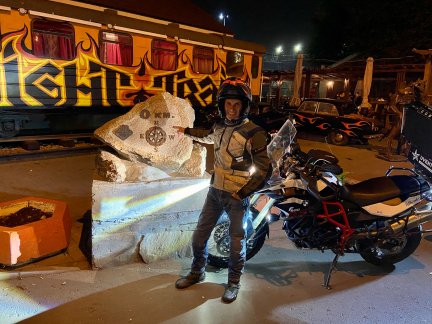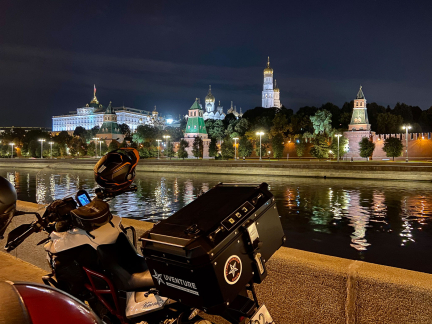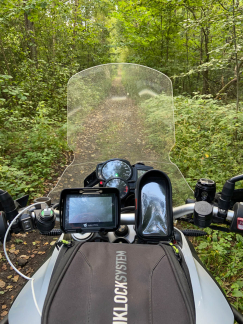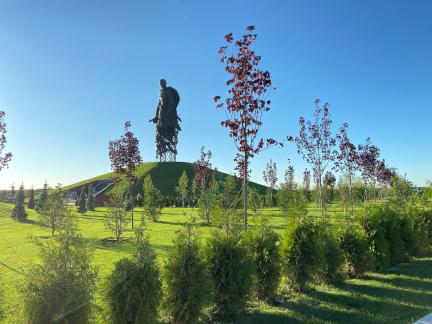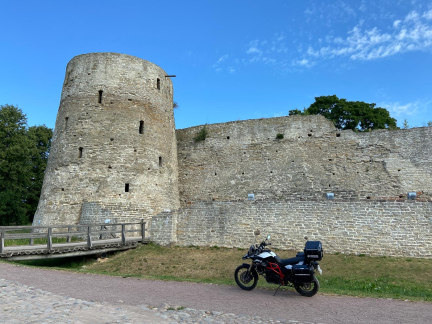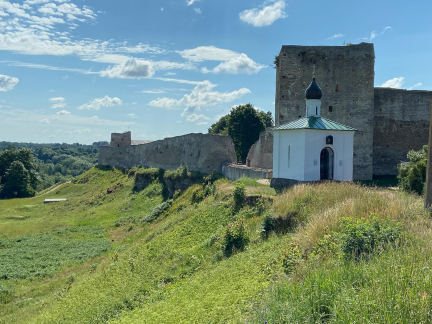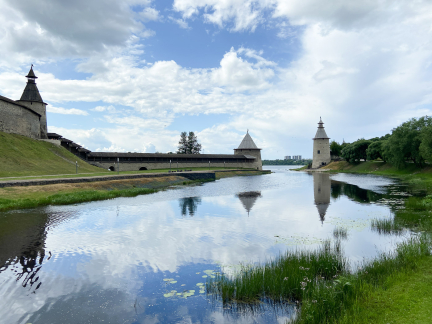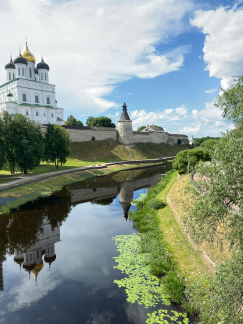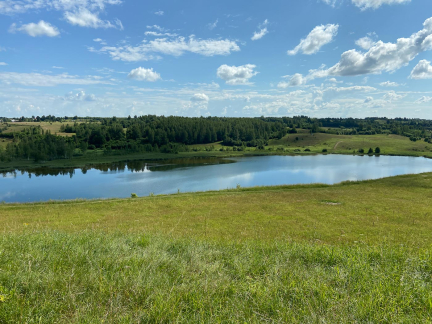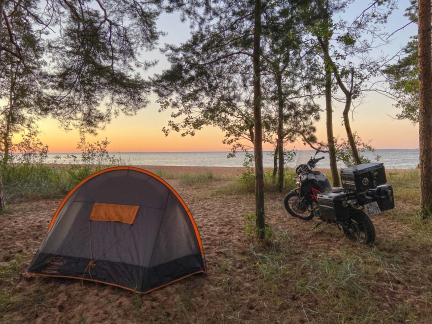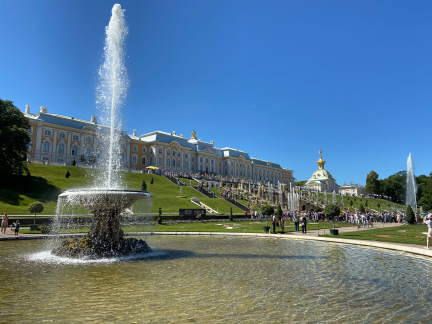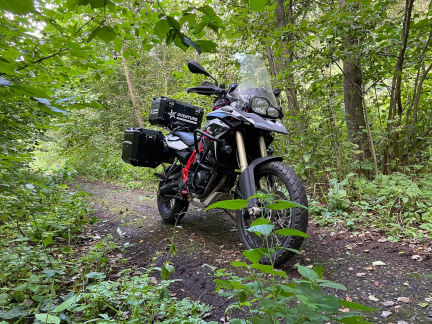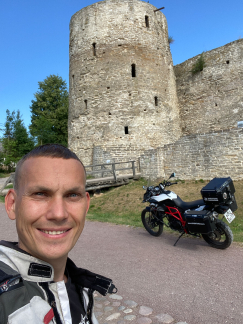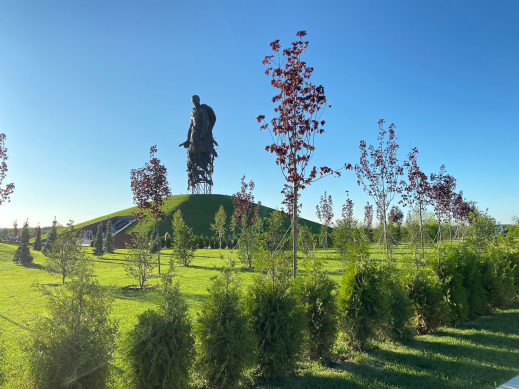Yuri Kalika
Moscow – St. Petersburg
I think if you ask any foreigner what cities he knows in Russia, the first ones he will name are Moscow and St. Petersburg. These are the largest, most populated, most touristic and probably the most beautiful and well-groomed cities in Russia.
And if you look at the map, there are only 700 kilometers between Moscow and St. Petersburg which is very close by Russian standards. However, this is a straight toll road, which is very boring for motorcycle trips.
Therefore, I decided to build my route from Moscow to St. Petersburg along secondary roads, through other interesting cities and authentic villages – just the way real motorcycle travelers love to do it.
Moscow by Night
I know Moscow very well and my friends and I decided to explore it at night. At night Moscow looks completely different – very beautiful illumination is everywhere and it feels like this city never falls asleep. We took a photo near the Kremlin, rode around the center of Moscow, along cozy lanes with historical buildings, then drove to the embankment opposite to the business center of Moscow which is called Moscow City. I was very surprised when I read on Wikipedia that 8 of the 10 tallest buildings in Europe are located in Russia. And the Top 5 tallest buildings in Europe are located in Moscow and St. Petersburg.
You can see 4 of them right behind my motorcycles in the Moscow City business district.
And then we went to two l of the most iconic biker’s places in Moscow. The first is the base of the Night Wolves ( Nochnie Volky) and their nightclub Sexton, and the second is the Night train – the place where the zero kilometer of Russian railways is located. There is also a very cool themed biker bar where we had real biker’s tea.
Volokolamsk, Yaropolets, Rzhev
I packed my camping gear and other equipment and drove alone west towards Latvia, moving along secondary roads or along the M9 highway. The weather was excellent and I decided to see as many sights as possible on the way. I drove and walked around Volokolamsk, which was founded in 1054 by Yaroslav the Wise. Actually, Volokolamsk is almost 100 years older than Moscow.
In the center of Volokolamsk there is a small but interesting Kremlin.
The Resurrection Cathedral (In Russian – Voskresenskiy sobor) was built around 1480 by order of Prince Boris Vasilyevich. The main building material was white stone. The cathedral was important for the defense of the Kremlin, strong walls and loopholes in the upper part of the building turned it into an impregnable “fortress”.
After visiting the Kremlin, I decided to dine at an excellent restaurant that I have known for a long time – Zotto Restaurant. If you are traveling from Latvia to Moscow through M9 highway it’s a good place for lunch.
My next point was hydroelectric power station in Yaropolets.
On the Lama River was the old watermill of Graph Chernyshev’s estate. The villagers decided to use its mechanism, but to improve the design. The canal did not need to be dug, and the dam for the mill was already built. During 1919, a 12 kW dynamo generator was added to the water mill, and it was connected to the filling wheel of the mill using a conventional belt drive.
And this structure was launched on November 7, 1919. And electricity appeared in the village houses, in the school, in the hospital and in the water pump.
This significant date went down in the history of Soviet and Russian energy-the appearance of the first rural Yaropoletskaya HYDROELECTRIC POWER STATION
Now it works as a museum and attracts many tourists due to its dam and the beauty of nature around.
Then I drove through the forest to find a beautiful observation deck on the Derzha River. There are very beautiful cliffs with spruce forests, which more resemble the Russian North – Karelia, and not the central part of Russia, where I am now traveling. It turned out to be very beautiful and peaceful there. And the road to this place was also very picturesque. I even regretted a little that I had not taken lunch with me and had not eaten here on the river bank, but had already done it in a restaurant.
Next, the city of Rzhev and its new memorial dedicated to the Soviet soldier was waiting for me. This huge 25-meter sculpture with a Museum complex reminds us of one of the bloodiest battles of the WWII. A truly impressive monument.
Such monuments remind us of the terrible mistakes of past generations, which I hope will not be repeated in the future.
I decided to spend the night at the recreation center Derbovezh which is located on the shore of the lake. I’ll start sleeping in a tent the next day and this night I’ll choose a cozy wooden house.
Ostrov and Izborsk
I slept well and was in no hurry. After breakfast I walked around the vast territory of the recreation center and took a dip. Then I went to the city of Ostrov, the main attraction of which is its suspension chain bridges and the church on the island. The bridges are really beautiful structures and in the park I also found a small monument on which a star was depicted, which is completely identical to the star on my logo, look at the photo!
Then I went to Izborsk and it impressed me so much. If you do not know, then you can just drive by on the highway. From the road, it looks like an ordinary small town or even a village. But that would be a huge mistake yo miss it! Be sure to stop by the Izborsk Fortress and Slovenian Keys. These are fantastic locations.
Izborsk was once a vital strategic city of Ancient Rus that fought off repeated attacks from swathes of enemy invaders.
The city of Izborsk on the western border of Russia is effectively where the Russian state began. According to legend, in 862 the divided Russian princes invited the Varangians (Vikings) from Sweden to come and establish order. Three heeded the call: Rurik, who became ruler of the strong Novgorod Republic, together with his younger brothers Sineus, who took Belozersk, and Truvor, who went to Izborsk. Truvor died just a couple of years later (his purported grave survives to this day).
From the 13th century onwards, the city was regularly attacked by the Teutonic Knights and other religious orders, with whom Russia was at war. Hence, in 1330, a powerful fort was built here. For a century, it withstood eight major sieges by the Livonians (a branch of the Teutonic Order), the longest of which lasted 18 days. The Livonians called Izborsk the “iron city” — not even battering rams could dent the walls. Only very few invaders ever managed to seize control of it. This select number included, for example, the Polish-Lithuanian king Stefan Bathory in the 16th century.
When Peter the Great founded St Petersburg, Izborsk, like Pskov, lost its significance and turned into a provincial city. During WWII, the city and the fort were occupied by German troops.
Today, the fort is popular with tourists and Orthodox pilgrims. Nearby are the Slovenian Springs, which are considered holy. They run straight off the side of a cliff into a lake full of paddling swans.
These are very beautiful places and they are only 5 minutes walk from the fortress.
After Izborsk I found a great place to spend the night. It was a beautiful field far from the road and by the lake.
Pskov
I dedicated this day to Pskov. I reached it very quickly – it is only 40 kilometers along a beautiful road. Leaving the motorcycle in the parking lot and changing into sneakers and shorts, I decided to walk around Pskov all day and learn more about its history. Pskov is a city in west Russia, near Estonia. It’s known for the Pskov Krom, a citadel whose fortress and Holy Trinity Cathedral date from medieval times. Pskov is one of the oldest cities in Russia. Its earliest mention comes in 903, which records that Igor of Kiev married a local lady from village Vybuty, Olga, afterwards known as St. Olga. Pskovians sometimes take this year as the city’s foundation date, and in 2003 a great jubilee took place to celebrate Pskov’s 1,100th anniversary. Pskov still preserves much of its medieval walls, built from the 13th century on. Its medieval citadel is called either the Krom or the Kremlin. Within its walls rises the 256-foot-tall (78 m) Trinity Cathedral, founded in 1138 and rebuilt in the 1690s.
By the 14th century, the town functioned as the capital of a de facto sovereign republic. Its most powerful force was the merchants who traded with the Hanseatic League. Pskov’s independence was formally recognized by Novgorod in 1348. Several years later, the veche promulgated a law code (called the Pskov Charter), which was one of the principal sources of the all-Russian law code issued in 1497. For Russia, the Pskov Republic was a bridge towards Europe; for Europe, it was a western outpost of Russia. Already in the 13th century German merchants were present in Zapskovye area of Pskov and the Hanseatic League had a trading post in the same area in the first half of 16th century which moved to Zavelichye after a fire in 1562. The wars with Livonian Order, Poland-Lithuania and Sweden interrupted the trade but it was maintained until the 17th century, with Swedish merchants gaining the upper hand eventually.
The importance of the city made it the subject of numerous sieges throughout its history. The Pskov Krom (or Kremlin) withstood twenty-six sieges in the 15th century alone. At one point, five stone walls ringed it, making the city practically impregnable. A local school of icon-painting flourished, and the local masons were considered the best in Russia. Many peculiar features of Russian architecture were first introduced in Pskov Under the Soviet government, large parts of the city were rebuilt, many ancient buildings, particularly churches, were demolished to give space for new constructions. During World War II, the medieval citadel provided little protection against modern artillery of Wehrmacht, and Pskov suffered substantial damage during the German occupation from July 9, 1941 until July 23, 1944. A huge portion of the population died during the war, and Pskov has since struggled to regain its traditional position as a major industrial and cultural center of Western Russia.
In the evening I decided to go in the direction of St. Petersburg, it was already late, but at this time in this region of Russia there are so-called white nights – when even at night it is light.
I chose the most beautiful road, which is located along the border with Estonia on the shore of Lake Peipsi. There are very few cars and a lot of beautiful forests and beaches.
I decided to drive to the Gulf of Finland and set up a tent on the shore of the bay. It was the best solution and decision! It was a stunning sandy beach and a pine forest in front of it. It is by staying in such places, spending the evening on the shore in silence and tranquility, that I understand why we love to travel so much. Falling asleep in a tent under the starry sky and the sound of the waves is what I call a million-star hotel.
St. Petersburg
By 7 o’clock in the morning the sun was shining brightly and my tent warmed up, so I woke up and immediately went for a walk along the sandy beach. Spent the morning here, swimming and sunbathing. I also met a group of local young people who also rested here with tents not far from me. They talked about many interesting places in the Leningrad Region, which I will definitely visit in the future. Then I packed all my things in Givi aluminum cases which are very large and sealed. Everything including tent and sleeping bag fits inside and there is no need to tie anything outside. This is very convenient. The whole image of Peterhof has been shaped over several centuries, allowing us in the 21st century to immerse ourselves in the atmosphere of Petersburg’s majestic history: take a stroll through Peterhof – the former summer residence of the Tsars, now a state museum-reserve. Here you can admire the varied marble fountain systems and visit the landscape parks and gardens.
After that, I went to the center of St. Petersburg, however, many of the central streets were blocked due to the ongoing European Football Championship. So I parked my motorcycle and went for a walk along the embankments. In summer, there are many boats on the canals and rivers of St. Petersburg. This is why St. Petersburg is called the Venice of the North.
I have already visited St. Petersburg many times by motorcycle and by car, so at 6 pm I decided that it was time to return home and in 8 hours I reached Moscow along the highway, stopping only for rest and refueling. It was fascinating to see that after 10 o’clock in the evening it was getting dark ahead of me in the direction of Moscow, but when I looked back in the rear-view mirrors, there was a much brighter sky in the direction of St. Petersburg.
I love the white nights of the Northern cities of Russia.
As a result, it turned out to be an excellent route from Moscow to St. Petersburg, which is worth riding at least once in your life and seeing all these beauties with your own eyes.
The protagonist
Yuri Kalika
The protagonist
Yuri Kalika
Motorcycle equipment
long motorcycle journeys
GIVI offers an extensive range
of motorcycle touring accessories
GIVI offers an extensive range
of motorcycle touring accessories

